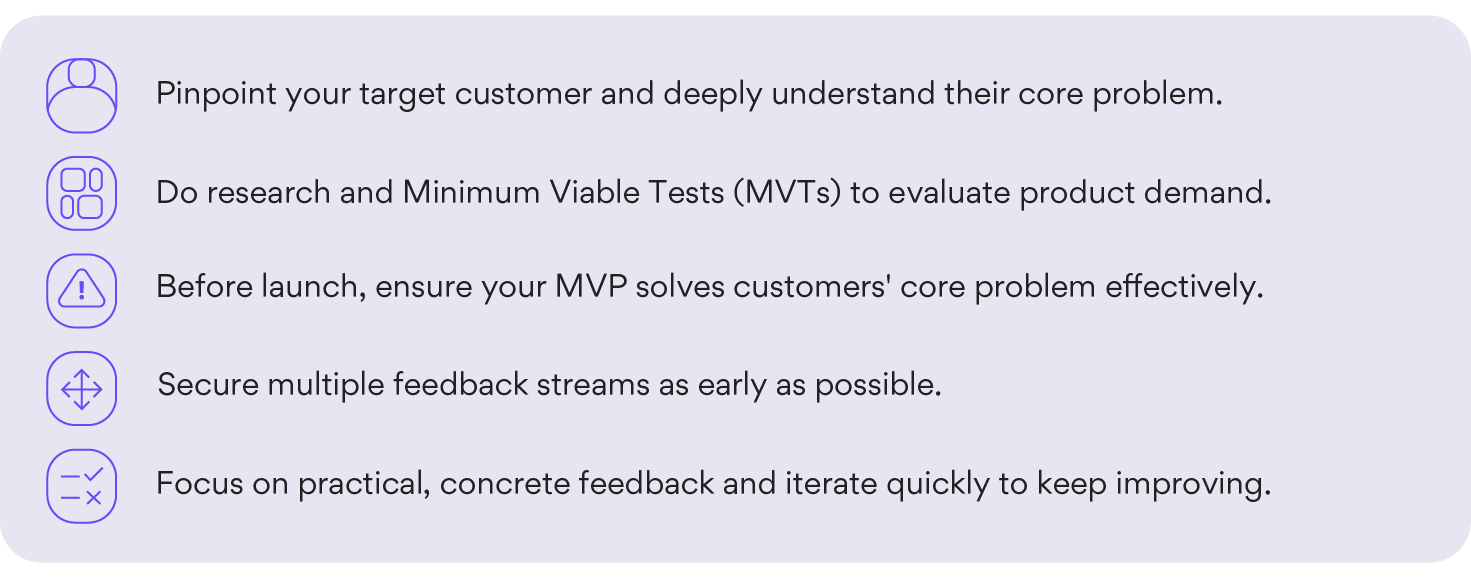
Product mistakes can kill your startup – here are 4 to avoid
June 21, 2023•5 mins read
The startups that succeed solve real-world problems. “If their product fails to do its job and effectively solve the problem it’s meant to solve, users will simply choose to invest their limited time, energy, and money elsewhere,” says Aivaras Vencevičius, Head of Product at NordLocker.
To put it another way, activities like marketing, sales, and support are worthless without a strong product: “No matter the discounts, media buzz, or advertising budget, a startup can’t survive without a solid product to its name,” says Aivaras.
We asked Aivaras to share the most common product mistakes he sees, and how to avoid them. After all, as Aivaras points out, these mistakes can be extremely damaging, even fatal, for your startup. “Make too many costly mistakes, and you’re out of time,” explains Aivaras. “Make too many judgements that cause delays, and you’re out of money”.
Covering topics including customer feedback, market launch, and meeting customer needs, here are 4 common mistakes to be wary of.
Mistake #1: Putting too much stock in media hype
“This problem usually happens in the product development stage,” explains Aivaras.

There have been high-profile examples of this mistake. Take Juicero, which raised $120 million riding the Internet of Things wave. Its product offered customers a $700 solution to a task (squeezing juice out of a bag) they could do just as well by hand. Unsurprisingly, it tanked.
While this may be an extreme example, Aivaras believes it is all too easy for startups to lose focus on customer needs when you’re working with exciting new tech. “A closer look at products in trending areas like Web 3.0, Blockchain, or AI reveals that very few of them actually offer a better way of doing something,” Aivaras says.
What’s the solution?
Invest time and energy understanding your customers and the problems they have before you decide which solution to build. “You should break the core problem down to its smallest components,” says Aivaras. “Then make sure you fully understand your prospective customers’ behaviour and key motivating factors.”
Mistake #2: Launching too early or too late
There are two aspects to the product launch question – is the market ready, and are you?
When it comes to the market, arriving too early is dangerous, says Aivaras: “Releasing a good product to a market that’s not yet ready for it can be a decisive mistake for any startup”. But release too late and the field is flooded with competitors.
There is a similar dilemma with product development. Launching too early with a low-quality product that lacks core functionality can be hard to recover from.
“On the other hand,” says Aivaras, “a long development time equals tons of money spent and revenue left on the table. In addition, it deprives you of user feedback, so it’s difficult to know whether there’s actual need for your product.”
What’s the solution?
So how do you get the timing just right? First, make a thorough survey of the market to ensure there’s sufficient demand. Try minimum viable tests (MVTs) to prove your hypothesis.
Then when it comes to building your MVP, be crystal clear on what core functionality it needs, and get there as soon as possible. Then you can adjust and tailor. “Make use of the feedback you get from early adopters,” advises Aivaras. “Then use it to iterate through several product versions and do regular updates.”
Mistake #3: Catering to everyone and no one
Startups fall for this one all the time, creating a product geared towards pleasing a broad range of customer types that ends up pleasing no one.
Aivaras understands why this happens: “Startups work tirelessly to attract new users and clients. This is, no doubt, one of the keys to success.”
“The risk, however, is that product developers overemphasise client feedback, especially comments from the most vocal users,” he continues. “Implementing every suggestion can easily shift their focus away from perfecting core functionality to tinkering with secondary features.”
What’s the solution?
Before you start product development, map out two things as precisely as you can: who are your main customers, and what is your core business.
“All the suggested improvements can gradually be added, but never at the expense of having a solid, functional MVP,” Aivaras says.
Mistake #4: Ignoring valuable feedback
This is the opposite problem to mistake #3. Instead of doing everything our customers tell us to, we ignore them completely, comforting ourselves with the Henry Ford quote: “If I had asked people what they wanted, they would have said faster horses”.
To make their novel solution see the light of day, startups must stick to their vision and exercise both patience and determination. However, warns Aivaras, “you shouldn’t bank on the idea that people simply ‘don’t know what they want until we show them’. Feedback is a crucial part of product development.”
What’s the solution?
Establish feedback streams as early as possible and collect as much as you can from users and other stakeholders.
“This is not to say you should cater to everyone’s needs,” Aivaras explains. “Feedback has to be properly sorted to extract actionable insights, rather than regarded as the sole source of truth. When it comes to handling feedback, my suggestion is to focus on the bits related to problems that users actually have”.
A product checklist for success
To finish, here’s Aivaras’ checklist of best practices for developing and launching your product:

Follow this checklist and embrace Aivaras’ sound advice to build the foundation for your startup’s long-term success.







